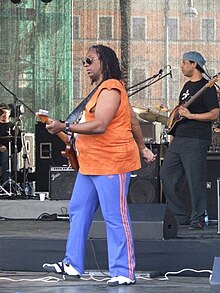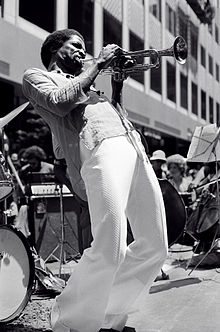The Monday Night Orchestra
| The Monday Night Orchestra | |
|---|---|
| General information | |
| Genre (s) | Modern jazz , rock jazz |
| founding | 1983 |
| Founding members | |
Leader, electric piano , arrangement |
Gil Evans |
| George Adams | |
Saxophones |
David Sanborn |
| Hannibal Marvin Peterson | |
Trumpet |
Lew Soloff |
| John Clark | |
| Tom Malone | |
trombone |
Dave Taylor |
trombone |
Dave Bargeron |
| Howard Johnson | |
| Pete Levin | |
| Hiram Bullock | |
| Mark Egan | |
| Adam Nussbaum | |
The Monday Night Orchestra is an American jazz formation that worked from 1983 to the 1990s, initially under the direction of Gil Evans . The band name is derived from the orchestra's concerts on Mondays at the New York jazz club Sweet Basil .
Band history
Since Mondays were traditionally the day most New York clubs were closed, some club owners gave unknown musicians and groups the chance to perform on that day. A first example of this practice was the Thad Jones / Mel Lewis Orchestra in the Village Vanguard , from which the Vanguard Orchestra emerged in 1990 . In the early 1980s, Horst Liepold, the German-born co-owner of Sweet Basil (88 Seventh Avenue South) in Greenwich Village , tried something similar and in early 1983 gave Gil Evans the chance to perform with his 15- to 16-person ensemble for $ 900 per gig. This was a very low reward even for a Monday, so the band members actually played "for little more than the fare". Liepold relied on the legendary connection with Miles Davis , which should arouse curiosity; “Others were curious about what Evans was doing now; still others couldn't wait to see someone of Gil Evans' stature in a small, intimate club without knowing what he was going to do. "
The orchestra gave its first appearance on April 17, 1983. The club's small stage with only 40 tables was enough for a sextet that now had to accommodate Evans' fourteen musicians: First the saxophonists David Sanborn and George Adams . Pete Levin was the second keyboardist next to the band leader; Added to this were the brass , Dave Taylor and Dave Bargeron on the trombones , Lew Soloff and Hannibal Marvin Peterson on the trumpets and the tuba player Howard Johnson , who stood directly in front of the first row of tables. Guitarist Hiram Bullock posed to the side of the stage .
The concert began with a "wild version" of Orgone based on Gone , known from the Evans / Davis album Porgy and Bess (1958) and reminiscent of Wilhelm Reich's orgone theory under the new name . After Short Visit , a feature for Sanborn, followed by an Evans-arrangement of Orange Was the Color of Her Dress Then Blue Silk , which had enough room for a slow anabolic solo by George Adams; the Mingus composition should then be part of the band's repertoire. Just a few weeks after this concert, “Monday nights belonged to Gil Evans.” In the last four years of his life, he and his orchestra performed here regularly when they were not on tour; so this engagement became the longest in his career to date. The concerts were well attended; there came u. a. Mick Jagger , Gerry Mulligan , Michael Caine and the bassist Jaco Pastorius . Gil Evans' family also participated; his wife, Anita, sat at the center table, surrounded by friends, musicians, and people from the music industry, Miles Evans played the trumpet, and Noah Evans worked as a sound engineer.
The band typically played two to four tracks per set, some stretched to over twenty minutes of improvisation. These included Orgone , a Jimi Hendrix song, a Mingus or Thelonious Monk composition, and one by Evans himself. For a while, his composition Bud and Bird was the final number, an upbeat suite of themes by the bop masters Bud Powell and Charlie Parker .
The continuity of the Monday Night gigs allowed Evans and the band to expand on the experiments he began with his band projects in the 1970s. Some of his arrangements were not very detailed and so flexible that they “explode improvisationally - for individual soloists, collectively or in a combination of both. Orgone is a classic example ; in its latest version you can hear an electronically expanded palette of sounds, and an array of rhythms hardly resembles the 4/4 swing of the old version [from 1958]. ”Gil's comments did not always guarantee a great performance, however; At times the music resulted in a "chaotic, uninspired game without a center". Gil Evans himself saw this calmly:
- "I love this band, we've been playing together for so long that we can improvise, get by with it and land on our feet. Some nights are better than others. We teeter on the edge of formlessness a lot of times - than someone can't stand it any longer and will do something definitive and we all move on. "
In Sweet Basil 1986 recordings for the Japanese label King were recorded in the period from August 1984 to December, but were of varying quality. The first two albums, Live at Sweet Basil, Vol. 1 & 2 , “although a bit uneven, captured the noisy wildness and excellent solos that also characterize the Live at the Public Theater recordings.” The other two, first After Evans' death in 1988, the albums Bud and Bird and Farewell were "far more inconsistent, both musically and technically." Gil Evans himself was dissatisfied with the third part, so he informed the Japanese producer that he did not wish that the recordings are published. However, this had already pressed 1500 copies for the Japanese market and said: “ It's just the first 1500, it's only for Japan ”, to which Evans replied: “ You mean you don't think the Japanes have as much sensivity as Americans or other people ? "
In the next few years (during the band leader's lifetime) the orchestra also included a. Shunzo Ohno , Stanton Davis , Chris Hunter , Bill Evans , Danny Gottlieb , Hamiet Bluiett , George Lewis in a more or less solid form, the z. Some of them also participated in the latter's European tours, most recently at the Umbria Jazz Festival from July 12th to 19th, 1987, when the orchestra performed with the singer Sting . After the band leader's death - again at the Umbria Jazz Festival - musicians from the Monday Night Orchestra under the direction of Gil Goldstein played with guests such as Urszula Dudziak , Michal Urbaniak and Biréli Lagrène ; the recordings appeared on the Soul Note album Tribute to Gil . Goldstein and Miles Evans continued the Monday Night Orchestra in the 1990s.
Appreciation
Joachim-Ernst Berendt considered Gil Evans' Monday Night Orchestra to be the most important of those big bands of the 1970s and 1980s in which "rock elements are creatively processed," to which he includes the Bob Moses Band, the Bob Mintzer Big Band Jaco Pastorius Big Band, Edward Wilkerson's Shadow Vignettes and in Europe the United Jazz + Rock Ensemble and the British formation Loose Tubes counted.
Discographic notes
- Live At Sweet Basil (Electric Bird, 1984, ed. 1985)
- Live At Sweet Basil Vol. 2 (Electric Bird, 1984, ed. 1986)
- Farewell - Live At Sweet Basil (Electric Bird, 1986, ed. 1988)
- Bud and Bird (Evidence, 1986, ed. 1992)
- Live at Umbria Jazz Vol. 1 (Egea, 1987, ed. 2000)
- Live at Umbria Jazz Vol. 2 (Egea, 1987, ed. 2001)
- The Gold Collection (Fine Tune, 1981–86, ed. 1999)
- Playing the Music of Gil Evans. Vol. 1 (Sweet Basil / Apollon, 1993)
- Playing the Music of Gil Evans. Vol. 2 (Sweet Basil / Apollon, 1993, ed. 1994)
literature
- Raymond Horricks: Svengali, or the Orchestra Called Gil Evans (1984, Spellmount, 96 p., En)
- Stephanie Stein Crease: Gil Evans: Out of the Cool - His life and music. (2001, A Cappella Books, 384 pp. En)
Individual evidence
- ↑ Stein, p. 303
- ↑ a b Stein, p. 304
- ↑ Stein, p. 305.
- ↑ Evans, who had done therapy with the Reich student Oscar Tropp, renamed the piece in 1967. See Stein, p. 340 (note 25)
- ↑ Stein, p. 306.
- ↑ a b Stein, p. 307.
- ↑ Stein, p. 308.
- ↑ a b Stein, p. 316.
- ↑ Stein, p. 371 ff.
- ↑ Tribute to Gil
- ^ New York Magazine Aug 1, 1994
- ^ New York Magazine Jul 20, 1992
- ↑ Berendt & Huesmann, Das Jazzbuch, Frankfurt, Fischer, 1994, p. 530.

